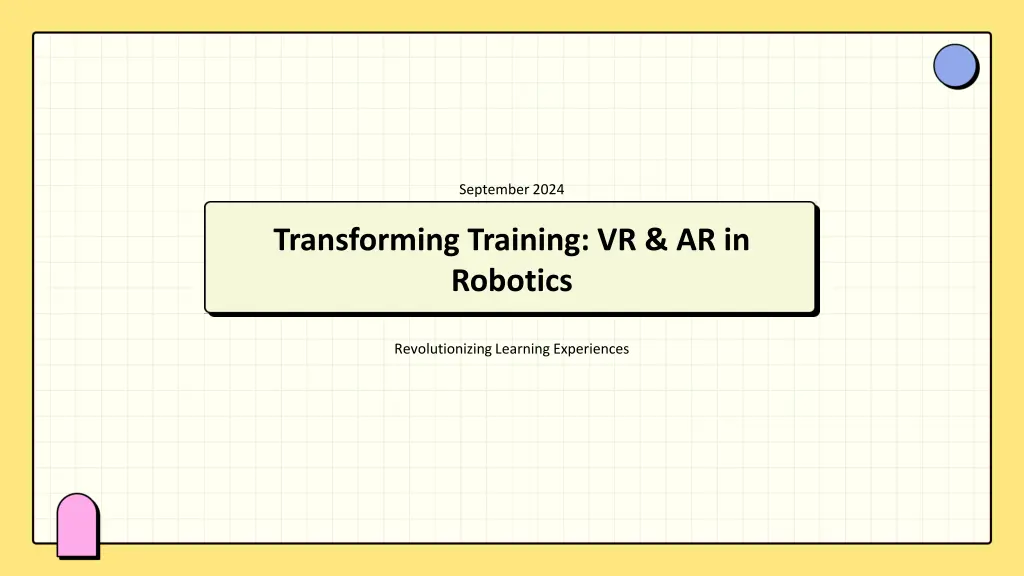
Revolutionizing Learning Experiences with VR and AR in Robotics Training
"Explore how Virtual Reality (VR) and Augmented Reality (AR) technologies are reshaping training in robotics, offering immersive experiences, enhancing learning outcomes, and providing cost-effective solutions. Discover the impact of VR and AR on diverse fields and industries, from increased engagement to real-world applications and reduced training costs."
Download Presentation

Please find below an Image/Link to download the presentation.
The content on the website is provided AS IS for your information and personal use only. It may not be sold, licensed, or shared on other websites without obtaining consent from the author. If you encounter any issues during the download, it is possible that the publisher has removed the file from their server.
You are allowed to download the files provided on this website for personal or commercial use, subject to the condition that they are used lawfully. All files are the property of their respective owners.
The content on the website is provided AS IS for your information and personal use only. It may not be sold, licensed, or shared on other websites without obtaining consent from the author.
E N D
Presentation Transcript
September 2024 Transforming Training: VR & AR in Robotics Revolutionizing Learning Experiences
Table of Contents 5 Customization and Adaptability 1 The Future of Training 6 Collaborative Learning Environments 2 Enhanced Learning Outcomes Real-World Applications 7 Measuring Effectiveness 3 Cost-Effective Solutions 8 Accessibility for All 4
9 Challenges Ahead 10 Future Prospects 11 Key Takeaways 12 Thank You!
The Future of Training 1. Virtual and Augmented Reality are transforming how we perceive training, offering immersive experiences that go beyond traditional methods. 2. These technologies engage learners in dynamic environments, enhancing interaction and retention of skills. 3. As robotics training evolves, leveraging VR and AR creates opportunities for diverse fields and industries. Photo by Pexels 4. This presentation explores the profound impact of VR and AR in robot-assisted training.
Enhanced Learning Outcomes 1. Studies show VR and AR increase engagement and and motivation in trainees, leading to improved learning learning outcomes. 2. The interactive nature of these technologies promotes deeper understanding of complex concepts in robotics. 3. Enhanced visuals and hands-on experiences encourage retention and application of knowledge. Photo by Pexels 4. Emphasizing experiential learning, VR and AR create memorable training sessions.
Real-World Applications 1. VR and AR are not just concepts; they are revolutionizing revolutionizing real-world applications in robotics today. today. 2. From surgical training to industrial robotics, these technologies provide simulations that mimic real-life scenarios. 3. This prepares trainees for actual challenges, reducing error rates and enhancing safety. Photo by Pexels 4. Real-world practice through virtual mediums enhances readiness and confidence.
Cost-Effective Solutions 1. Implementing VR and AR technologies in training can be can be more cost-effective than traditional methods. methods. 2. They reduce the need for physical resources and allow for repeated practice without additional costs. 3. This small investment can lead to substantial savings in training budgets over time. Photo by Pexels 4. Cost-effective training solutions make advanced technologies accessible to all sectors.
Customization and Adaptability Adaptability 1. VR and AR technologies offer customizable training training experiences tailored to individual learner needs. needs. 2. This personalization increases motivation and helps in addressing specific skill gaps. 3. Adaptable content ensures that each trainee receives relevant knowledge and practice. Photo by Pexels 4. Flexibility in training leads to greater learner satisfaction and effectiveness.
Collaborative Learning Environments 1. VR and AR foster collaborative training experiences, experiences, allowing teams to work together in virtual virtual spaces. 2. Team-based scenarios promote communication, problem- solving, and strategic thinking beyond the classroom. 3. This nurtures essential soft skills, preparing trainees for collaborative roles in their careers. Photo by Pexels 4. Working together in immersive environments strengthens team dynamics.
Measuring Effectiveness 1. Utilizing analytics in VR and AR training provides data that data that measures effectiveness and learner progress. progress. 2. This feedback loop allows for continuous improvement in training methodologies. 3. Understanding learner behavior helps in refining subsequent training experiences. Photo by Pexels 4. Data-driven insights enhance the quality of training programs.
Accessibility for All 1. VR and AR technologies democratize access to training training resources, reaching diverse populations. 2. Virtual trainings can overcome geographic limitations, making expert training available globally. 3. These technologies can be adjusted for various learning abilities, ensuring inclusivity. 4. Accessibility leads to a more educated and skilled Photo by Pexels workforce.
Challenges Ahead 1. Despite the advantages, challenges such as high development costs and technology acceptance remain. remain. 2. Training facilitators must provide adequate support for trainees to adapt to new environments. 3. Addressing resistance to change is crucial for successful integration of VR and AR in training. Photo by Pexels 4. Continuous dialogue about the benefits helps alleviate concerns.
Future Prospects 1. The future of training with VR and AR is promising, with promising, with ongoing advancements in technology. technology. 2. As these tools evolve, we can expect even more immersive and effective training solutions. 3. Innovations will tailor experiences to varied industries, enhancing learning opportunities. Photo by Pexels 4. This journey is just beginning; the sky is the limit!
Key Takeaways 1. The integration of VR and AR in training offers immense immense potential for enhancement in various fields. fields. 2. From improved engagement and collaboration to accessibility, the benefits are clear and impactful. 3. It's essential to embrace these technologies for a more skilled future workforce. Photo by Pexels 4. Let s continue to explore and innovate for better training experiences!
Thank You! 1. Thank you for joining this presentation on the transformative role of VR and AR in robot-assisted training. 2. Together, we can revolutionize training approaches and enhance learning outcomes across industries. 3. Feel free to reach out for further discussions and collaboration opportunities. Photo by Pexels 4. Let s continue inspiring each other towards a better future in training.
